Pedals & Pathways: Tour of Manchester, 41,000 Traffic Deaths, Vision Zero
Hello Manchester! Let’s continue our conversation about adventures in our beautiful city on foot, scooter, bicycle, etc. Summer’s not gone yet, and there are still some wonderful days ahead. So let’s dive in!


Navigating Manchester’s Urban Paths
Hello Manchester! Let’s continue our conversation about adventures in our beautiful city on foot, scooter, bicycle, etc. Summer’s not gone yet, and there are still some wonderful days ahead. So let’s dive in!
In this edition, let’s talk about ….
- Tour of Manchester
- USA Today says crashes killed 41,000
- Kansas City adds 100 speed humps
- Vision Zero
Tour of Manchester

A great group ride returns to Manchester on Sunday, September 22nd, offering 8, 22 and 30 mile options, with Ride Marshalls to help along the way, and even with lunch at the end! See more here.
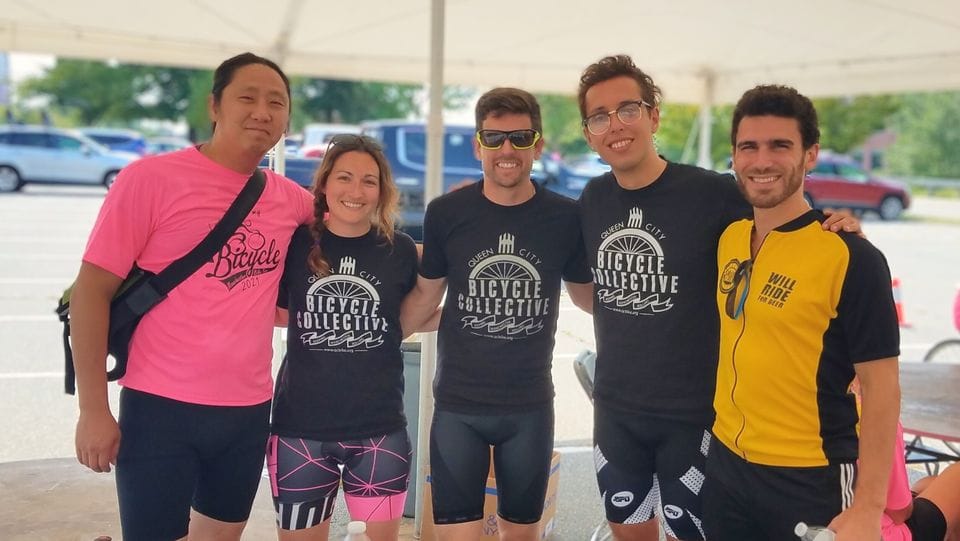
Or click here to register. Note that scholarships are available for those who need assistance with the registration fee. Also, they still need volunteers! To volunteer click here.
USA Today: 41,000 killed in crashes
Incredibly, a truck driver near Phoenix last year was watching TikTok while speeding. He caused a crash that killed five people. Now he’ll spend 22 years in prison. Unbelievable! The National Highway Traffic Safety Administration reports that other traffic accidents last year killed about 41,000 people. Just for comparison, the World Trade Center 9/11 attacks killed 2,996 people. So in one year, ordinary traffic kills about 13 World Trade Center attack’s worth of people. Yet in sharp contrast we seem numb to traffic accidents. And, even more troubling, this number is trending upward over the last decade.
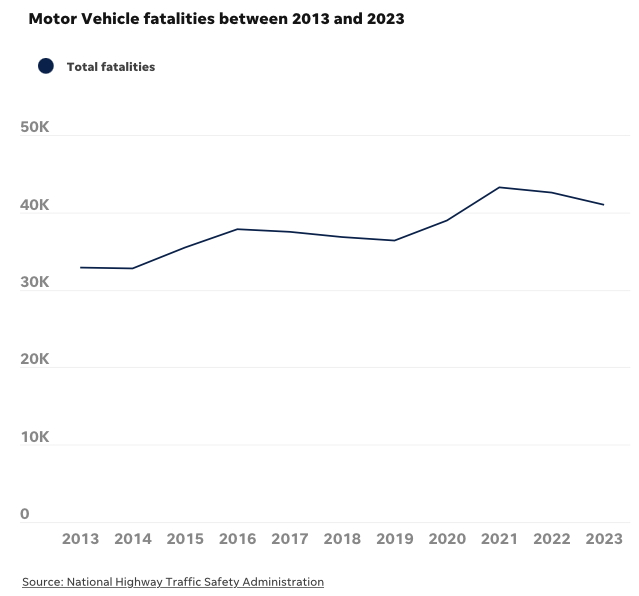
What can be done about traffic deaths? I’m glad you asked! Below is one example from Kansas City, MO.
Kansas City Missouri speed humps
KC’s City Council last month approved installing 100 new speed humps at about 50 locations around the city. This is part of its Vision Zero initiative, which aims to eliminate traffic fatalities and serious injuries by 2030.
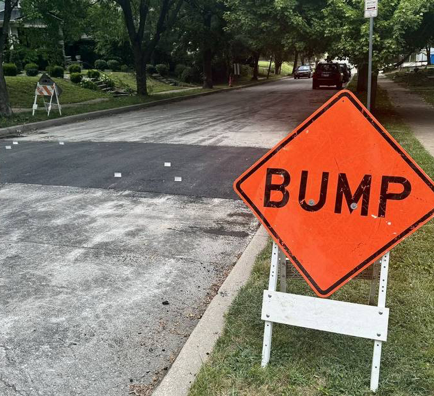
The traffic calming mechanism requires drivers to slow their vehicles to avoid a jarring bump as they go over the hump. (Here in Manchester you can experience these on the campus of SNHU.) The speed humps are in response to traffic calming requests submitted through the city’s 311 system. The installation of the speed humps at the selected locations has already began, and is being coordinated with the city’s street resurfacing schedule.
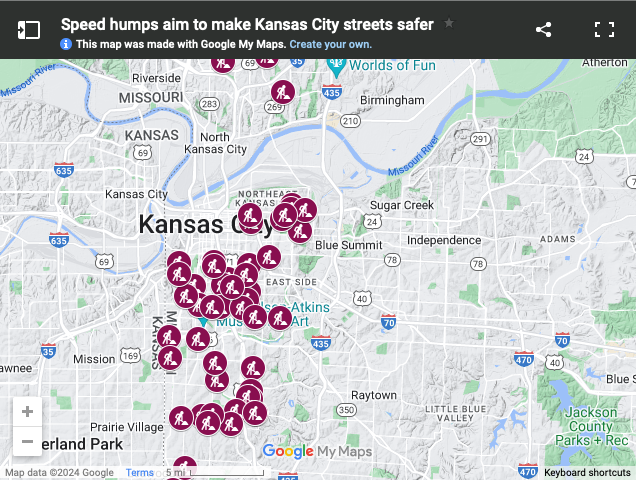
Hump locations were selected based upon several factors, including proximity to the city’s high injury locations and schools.
KC lets citizens suggest locations for speed humps via the city’s website. In Manchester we can use SeeClickFix for those kinds of requests. Read more here.
Kansas City speed humps are just one example of safety-oriented improvements that cities can make. What are others? Many of them fall under a rubric called “Vision Zero.”
What is Vision Zero?
Bear with me a moment as I bask in some memories. I spent much of my working life as a software engineer, before I started writing these snazzy columns. I specialized in the graphical user-interface or user experience of software. Much of that work focused on the visual appearance of a software product and the arrangement of information on a screen.
In the software design field, we all recognized that our users, or customers, were ordinary mortal humans. None were perfect. They would be affected by distractions and by other tasks competing for their time and attention. In short, they would make mistakes. We believed that part of our job was to minimize the likelihood of those mistakes. We tried to design the software so that, for the user, it would be easy, natural & straightforward to complete at task smoothly and correctly, and would be difficult (and thus unlikely) for them to make a mistake.
We also recognized that even with our best design, mistakes would still happen, because, again, our users were human. So another vital aspect of our job was to minimize the impact or cost of those mistakes. The more costly the mistake, the more time and attention we spent to reduce its likelihood. Ideally, we’d find ways to make the most egregious mistakes simply impossible. But in some cases, our best solution was to flash up the message “Are you sure?” to the user, along with buttons for yes or no.
My main point here is that we knew users would make mistakes, and had to build the system taking that into account. We could not rely on our users operating flawlessly, because in reality no such users exist.
That’s a quick summary of my personal experience in the software design field. But there’s another field where humans use some fairly complex systems, and that field assumes those users will operate flawlessly.
I’m talking about our system of streets, roads, and highways, along with the multi-ton machines that navigate them. As long as the lone human driver operates his vehicle correctly and obeys traffic laws without mistake, while also remaining alert for dogs, delivery vans, playing children and pedestrians, and using proper judgement for pot holes & wet or icy roads, and avoiding distraction from noisy passengers, then accidents should not happen. And if they *do* happen (spoiler alert: they do!), we can comfortably assign blame to the faulty driver. Apparently every accident is the fault of a driver (or a pedestrian, or a cyclist); always owing to some faulty in-the-moment judgement error. These errors must be common, because, as we learned above, more than 40,000 people are killed on U.S. roads each year.
But a different view is possible. In this view, the likelihood of traffic accidents is influenced by many factors in addition to driver judgement: vehicle complexity, road signage and markings, speed limit, paving quality, cross-walks, lane width, obstacles reducing visibility, weather conditions. Much like software, many aspects of the car and the road operate in concert as a system, influencing the likelihood that the human operator will make (or avoid) a mistake. In fact, it can be argued that every single traffic accident happens due to a confluence of many of the above factors. (Some even argue that the word “accident” is a misnomer.)
And when an accident does happen, the severity of that accident is also impacted by many factors: vehicle construction, speed limit, presence of head-restraints, seat belts, air bags, nearness of rigid obstacles to the road.
So it can be argued that both likelihood and severity of accidents are influenced by many factors. Furthermore, many of those factors can be anticipated and systems can be designed to handle them.
For most software, the worst consequence of a mistake is some loss of data. Rarely is human life at stake. But when operating an automobile, even the most minor trips can and do place human life at stake. Yet we don’t behave as though that’s true. Instead, we treat it in a pretty cavalier way, as though we assign a low value to human life.
However, the view of roads & vehicles as part of an interconnected system, one where mistakes and their severity can be minimized by design, is gaining traction. It has become known by the name Vision Zero, because one of its admittedly lofty goals is to achieve zero human deaths from roads and vehicles.
If you’d like to read more about Vision Zero, you can do so here: visionzeronetwork.org.
Much of the information is fascinating and hopeful, but be aware there’s a lot of content there!
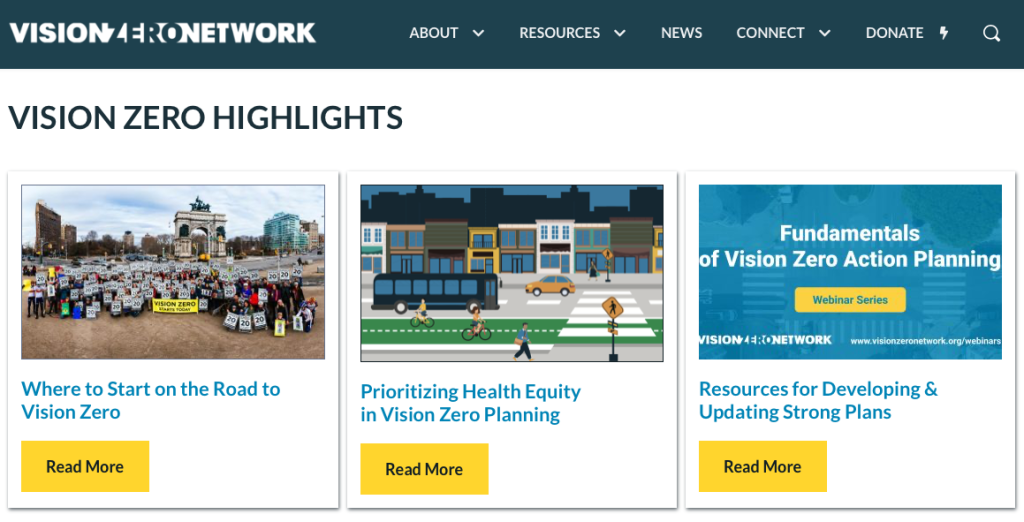
As examples, here are 15 U.S. cities that have adopted Vision Zero:
- Atlanta, Georgia
- Bethlehem, Pennsylvania
- Boston, Massachusetts
- Charlotte, North Carolina
- Chicago, Illinois
- Columbus, Ohio
- Ft. Lauderdale, Florida
- Harrisburg, Pennsylvania
- Louisville, Kentucky
- Macon, Georgia
- Orlando, Florida
- Philadelphia, Pennsylvania
- Seattle, Washington
- Tampa, Florida
- Washington, DC
A total of 59 U.S. cities have done so. They have all met the follow criteria:
- They have a clear goal of eliminating traffic fatalities and severe injuries.
- Their Mayor has publicly & officially committed to Vision Zero.
- A plan or strategy to achieve Vision Zero is in place, or the Mayor has committed to doing so in clear time frame.
- Key departments (including transportation, public health and mayors’ offices) are leading.
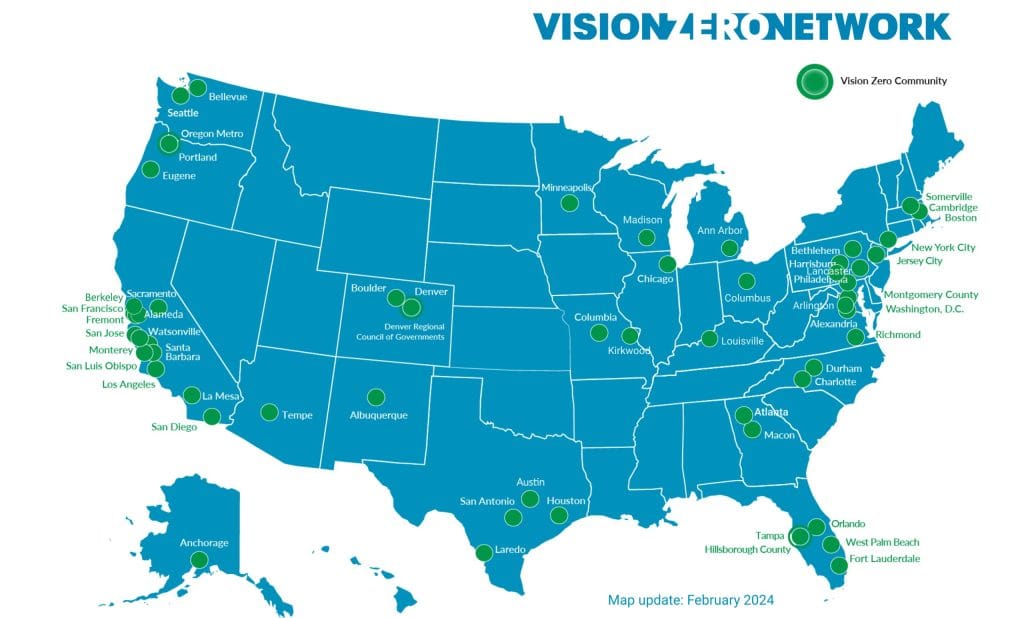
There are already some success stories. As of 2024, Hoboken, New Jersey, has committed to Vision Zero and achieved seven consecutive years without a traffic-related death. Jersey City, NJ, and Edina, Minn., also achieved years with zero deaths. Fremont, California reduced fatalities by 45% from 2015 to 2020 after launching Vision Zero. New York City streets are safer and more equitable – overall traffic deaths decreased more than 12% and pedestrian deaths decreased by 45% – in the first five years of Vision Zero investments.
Differences between the Traditional Approach vs. the Vision Zero Approach:

Principles of a Safe System Approach
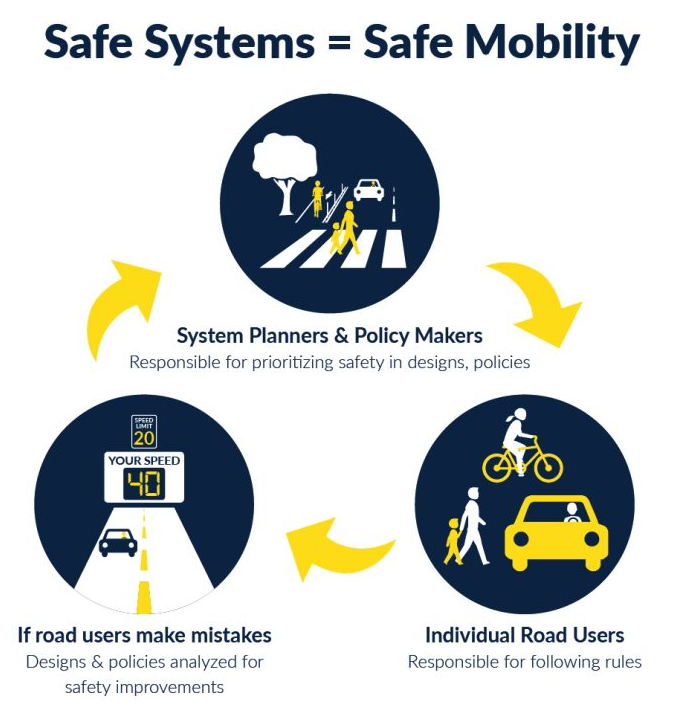
A Safe System Approach incorporates the following principles:
- Death and Serious Injuries are Unacceptable
- A Safe System Approach prioritizes the elimination of crashes that result in death and serious injuries.
- Humans Make Mistakes
- People will inevitably make mistakes and decisions that can lead or contribute to crashes, but the transportation system can be designed and operated to accommodate certain types and levels of human mistakes, and avoid death and serious injuries when a crash occurs.
- Humans Are Vulnerable
- Human bodies have physical limits for tolerating crash forces before death or serious injury occurs; therefore, it is critical to design and operate a transportation system that is human-centric and accommodates physical human vulnerabilities.
- Responsibility is Shared
- All stakeholders—including government at all levels, industry, non-profit/advocacy, researchers, and the general public—are vital to preventing fatalities and serious injuries on our roadways.
- Safety is Proactive
- Proactive tools should be used to identify and address safety issues in the transportation system, rather than waiting for crashes to occur and reacting afterwards.
- Redundancy is Crucial
- Reducing risks requires that all parts of the transportation system be strengthened, so that if one part fails, the other parts still protect people.
That’s about enough on Vision Zero for now, but we may revisit in the future. Questions and feedback are always welcome!
Call for Input
We very much want to hear from you! Do you have any questions or concerns? What topics would you like us to cover? Send your feedback our way and we’ll get on it! We want to ensure this column meets your needs.
Stay safe and have fun out there!





